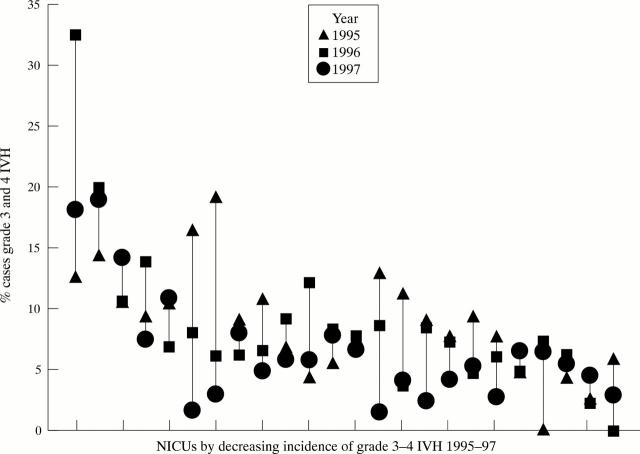Abstract
Background: In 1995, large differences were identified in rates of grade 3–4 intraventricular/periventricular haemorrhage (major IVH) among neonatal intensive care units (NICUs) in the Australian and New Zealand Neonatal Network.
Aims: To develop a predictive model for major IVH in order to allow risk adjustment for the variation in rates of major IVH among NICUs.
Methods: Rates of IVH were determined in 5712 infants of 24–30 weeks gestation born from 1995 to 1997. Significant antenatal and perinatal variables for major IVH in 1995 and 1996 were identified by univariate and multivariate analysis. A predictive model was developed and then validated on 1997 data.
Results: Rates of all grades of IVH fell from 1995 to 1997 (30.4 to 24.3%) but wide interunit variation remained. Seven antenatal and perinatal characteristics had significant association with major IVH: fetal distress, intrauterine growth restriction (protective), antenatal corticosteroids (protective), gestational age, 1 minute Apgar <4, male gender, and transfer after birth. A predictive model based on the last five of these variables was developed using data from 1995 and 1996 which gave an area under the receiver operator characteristic (ROC) curve of 0.76. This model was then validated on the 1997 dataset where an identical ROC curve resulted.
Conclusions: Antenatal and perinatal factors are important in the pathogenesis of major IVH. The predictive model developed from these factors can be used to adjust for confounders in interunit outcome comparison.
Full Text
The Full Text of this article is available as a PDF (120.7 KB).
Figure 1 .
Variation in annual rates of major IVH between and within NICUs from 1995 to 1997.
Selected References
These references are in PubMed. This may not be the complete list of references from this article.
- Beeby P. J., Elliott E. J., Henderson-Smart D. J., Rieger I. D. Predictive value of umbilical artery pH in preterm infants. Arch Dis Child. 1994 Sep;71(2):F93–F96. doi: 10.1136/fn.71.2.f93. [DOI] [PMC free article] [PubMed] [Google Scholar]
- Beverley D. W., Chance G. W., Coates C. F. Intraventricular haemorrhage--timing of occurrence and relationship to perinatal events. Br J Obstet Gynaecol. 1984 Oct;91(10):1007–1013. doi: 10.1111/j.1471-0528.1984.tb03679.x. [DOI] [PubMed] [Google Scholar]
- Clark C. E., Clyman R. I., Roth R. S., Sniderman S. H., Lane B., Ballard R. A. Risk factor analysis of intraventricular hemorrhage in low-birth-weight infants. J Pediatr. 1981 Oct;99(4):625–628. doi: 10.1016/s0022-3476(81)80276-4. [DOI] [PubMed] [Google Scholar]
- Gaudier F. L., Goldenberg R. L., Nelson K. G., Peralta-Carcelen M., DuBard M. B., Hauth J. C. Influence of acid-base status at birth and Apgar scores on survival in 500-1000-g infants. Obstet Gynecol. 1996 Feb;87(2):175–180. doi: 10.1016/0029-7844(95)00407-6. [DOI] [PubMed] [Google Scholar]
- Hannah M. E., Hannah W. J., Hewson S. A., Hodnett E. D., Saigal S., Willan A. R. Planned caesarean section versus planned vaginal birth for breech presentation at term: a randomised multicentre trial. Term Breech Trial Collaborative Group. Lancet. 2000 Oct 21;356(9239):1375–1383. doi: 10.1016/s0140-6736(00)02840-3. [DOI] [PubMed] [Google Scholar]
- Kluckow M., Evans N. Low superior vena cava flow and intraventricular haemorrhage in preterm infants. Arch Dis Child Fetal Neonatal Ed. 2000 May;82(3):F188–F194. doi: 10.1136/fn.82.3.F188. [DOI] [PMC free article] [PubMed] [Google Scholar]
- Ment L. R., Oh W., Philip A. G., Ehrenkranz R. A., Duncan C. C., Allan W., Taylor K. J., Schneider K., Katz K. H., Makuch R. W. Risk factors for early intraventricular hemorrhage in low birth weight infants. J Pediatr. 1992 Nov;121(5 Pt 1):776–783. doi: 10.1016/s0022-3476(05)81915-8. [DOI] [PubMed] [Google Scholar]
- Papile L. A., Burstein J., Burstein R., Koffler H. Incidence and evolution of subependymal and intraventricular hemorrhage: a study of infants with birth weights less than 1,500 gm. J Pediatr. 1978 Apr;92(4):529–534. doi: 10.1016/s0022-3476(78)80282-0. [DOI] [PubMed] [Google Scholar]
- Parry G. J., Gould C. R., McCabe C. J., Tarnow-Mordi W. O. Annual league tables of mortality in neonatal intensive care units: longitudinal study. International Neonatal Network and the Scottish Neonatal Consultants and Nurses Collaborative Study Group. BMJ. 1998 Jun 27;316(7149):1931–1935. doi: 10.1136/bmj.316.7149.1931. [DOI] [PMC free article] [PubMed] [Google Scholar]
- Perlman J. M., Risser R. C., Gee J. B. Pregnancy-induced hypertension and reduced intraventricular hemorrhage in preterm infants. Pediatr Neurol. 1997 Jul;17(1):29–33. doi: 10.1016/s0887-8994(97)00073-8. [DOI] [PubMed] [Google Scholar]
- Pollack M. M., Koch M. A., Bartel D. A., Rapoport I., Dhanireddy R., El-Mohandes A. A., Harkavy K., Subramanian K. N. A comparison of neonatal mortality risk prediction models in very low birth weight infants. Pediatrics. 2000 May;105(5):1051–1057. doi: 10.1542/peds.105.5.1051. [DOI] [PubMed] [Google Scholar]
- Richardson D. K., Gray J. E., McCormick M. C., Workman K., Goldmann D. A. Score for Neonatal Acute Physiology: a physiologic severity index for neonatal intensive care. Pediatrics. 1993 Mar;91(3):617–623. [PubMed] [Google Scholar]
- Richardson D., Tarnow-Mordi W. O., Lee S. K. Risk adjustment for quality improvement. Pediatrics. 1999 Jan;103(1 Suppl E):255–265. [PubMed] [Google Scholar]
- Shankaran S., Bauer C. R., Bain R., Wright L. L., Zachary J. Prenatal and perinatal risk and protective factors for neonatal intracranial hemorrhage. National Institute of Child Health and Human Development Neonatal Research Network. Arch Pediatr Adolesc Med. 1996 May;150(5):491–497. doi: 10.1001/archpedi.1996.02170300045009. [DOI] [PubMed] [Google Scholar]
- Synnes A. R., Chien L. Y., Peliowski A., Baboolal R., Lee S. K., Canadian NICU Network Variations in intraventricular hemorrhage incidence rates among Canadian neonatal intensive care units. J Pediatr. 2001 Apr;138(4):525–531. doi: 10.1067/mpd.2001.111822. [DOI] [PubMed] [Google Scholar]
- Szymonowicz W., Yu V. Y., Wilson F. E. Antecedents of periventricular haemorrhage in infants weighing 1250 g or less at birth. Arch Dis Child. 1984 Jan;59(1):13–17. doi: 10.1136/adc.59.1.13. [DOI] [PMC free article] [PubMed] [Google Scholar]
- Verma U., Tejani N., Klein S., Reale M. R., Beneck D., Figueroa R., Visintainer P. Obstetric antecedents of intraventricular hemorrhage and periventricular leukomalacia in the low-birth-weight neonate. Am J Obstet Gynecol. 1997 Feb;176(2):275–281. doi: 10.1016/s0002-9378(97)70485-x. [DOI] [PubMed] [Google Scholar]
- Yates D. W., Woodford M., Hollis S. Preliminary analysis of the care of injured patients in 33 British hospitals: first report of the United Kingdom major trauma outcome study. BMJ. 1992 Sep 26;305(6856):737–740. doi: 10.1136/bmj.305.6856.737. [DOI] [PMC free article] [PubMed] [Google Scholar]



